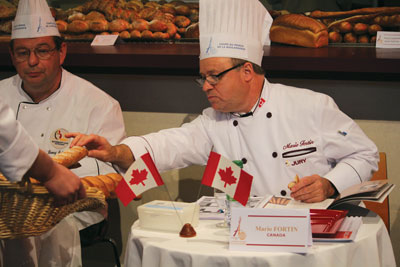
Tricks of the Trade: May 2012
April 18, 2012
By
FORMA-LAB
Being a member of the jury at the World Baking Cup for a second time has
given me more inside information for the next competition.
Being a member of the jury at the World Baking Cup for a second time has given me more inside information for the next competition. If your team is considering competing for the world title, you have to consider all minor details.
 |
|
| Mario Fortin inspecting bread at the world championship of baking.
|
Japan won the last World Baking Cup because they took care of everything. The American team finished second, with only five points. There are 200 points for each category (bread, Viennese products, artistic) and 100 points for savoury products, for a total of 700 points.
The first thing to do is read the rules. The second thing to do is read the rules. And then, read the rules again. Nobody remembers the rules after reading them only once. Failing to fully understand the rules is the major downfall of any team.
Read the rules until you understand everything you are requested to do. The only thing that you cannot control is which baking lab you will get during the contest.
If you are interested in participating in the contest, ask yourself these questions first:
- Are you able to work in front of the public for the nine-hour competition?
- Are you comfortable with a camera around you over the nine hours?
- Do you accept that jury members will be in front of you for nine hours?
- Are you ready to work under pressure? (Using flour from another country, working on new equipment, completing the program on time, answering questions during presentation of your products, working with others as a team member, etc.)
Supply validation of ingredients and materials a month in advance of the contest.
None of the ingredients may be scaled in advance. The only preparation that is accepted is maceration of fruits or vegetables. Premixing flour is not authorized.
Here are some guidelines for each of the categories:
The obligatory bread
Traditional baguette: must be made using flour without any treatment, must be made with pre-ferment, must be rolled by hand to a minimum of 55 centimetres in length, must include a minimum of five cuts, and after baking in a deck oven it must weight 250 grams
Varied baguette: must be made using flour with ascorbic acid, must undergo moulding by machine for a minimum of 55 centimetres in length, with the decoration of your choice (garnished with seeds, fougasse cuts, epi cuts, etc.)
Pain au levain (sourdough bread): must meet a pH of 4.3 or less. This bread is made with eight kilograms of flour and the weight, quantity, shape and baking methods are freestyle
Freestyle bread
- Bread of the world: freestyle made with seven kilograms of flour
- Organic and nutritional bread: freestyle made with seven kilograms of flour
- Bread of your country: freestyle made with seven kilograms of flour
obligatory Viennese products
Croissant and chocolatine: 20 pieces of each between 40 and 80 grams (must all be the same weight)
Freestyle Viennese products
- Three pieces at 300 grams and 15 pieces at 60 to 100 grams, same deco
- Two different products made out of fermented dough (brioche)
- Two different products made out of fermented and laminated dough (croissant or danish)
- One Viennese pastry from your country: freestyle out of two kilograms of flour
The savoury selection
- Le pain de Mie (sandwich bread) – 500 grams
- 40 hors d’oeuvres made out of long rolls (60 grams garnished)
- 40 hors d’oeuvres made freestyle shape (60 grams garnished)
- 40 savoury Viennese products salted (40 grams garnished)
- 40 club sandwiches made with gastronomy of your country (60 grams garnished)
Artistic piece
- Must be visible on three sides
- Maximum height of one metre
- Must contain a minimum of five different doughs, including 25 per cent live dough (with yeast)
- Must be in colour of bread (from white, yellow, orange, brown and black)
- Blue, red and green colours are prohibited
- The piece must include the presentation of 80 savouries (20 of each kind)
Scoring
Bread: Respect of weight, quantity, volume, taste, general appearance, texture of crumb, originality, creativity and consistency. Fifty per cent of the score is based on the taste.
Viennese products: Respect of weight, quantity, volume, taste, general appearance, flakiness, originality, creativity and consistency. Forty-two per cent of the score is based on the taste.
Savoury selection: Respect of weight, quantity, volume, taste, general appearance, integration into the artistic piece, originality, creativity and consistency. Forty per cent of the score is based on the taste.
Artistic piece: Originality (20 per cent), artistic quality (25 per cent), technical difficulty (25 per cent), use of various dough (10 per cent), overall harmony (10 per cent) and attention paid to the finish of the piece (10 per cent).
Penalties
A penalty can be deducted to a maximum of 10 points for the following reasons:
- time exceeded (one point per five minutes; maximum 25 minutes)
- cleanliness (two points)
- organization while working (1.5 points)
- professional appearance (1.5 points)
The winning teams practise a minimum of 20 to 30 times, nine hours at a time, as a team. That is the only way to ensure completion of everything on time. If you are not ready to invest at least 300 hours of your time, forget this, because you will never be at the level to compete against – and become – the best in the world.
It is a pleasure to share my experience. Good luck to the next competitors.
Mario Fortin is an international bakery consultant and owner of
FORMA-LAB, consulting services to Bakers and Suppliers. If you need
technical information, send your question to info @forma-lab.com.
Print this page
Leave a Reply